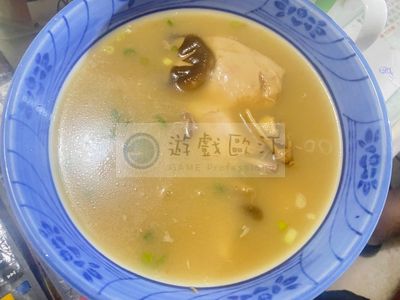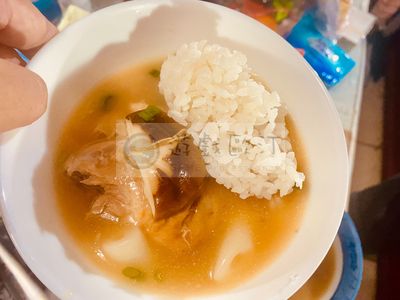韓國傳統的補身湯品:人蔘雞湯
韓國人蔘雞湯(삼계탕,Samgyetang)是一道韓國傳統的補身湯品,特別是在炎熱的夏季裡被認為具有補氣養身的效果。以整隻年輕雞(通常是春雞)為主料,內部填充糯米、紅棗、人蔘等食材,經過慢火長時間燉煮而成。由於雞肉嫩滑,湯汁清甜,並融合人蔘的香氣,深受韓國人喜愛。
人蔘雞湯的歷史可以追溯到朝鮮王朝時期,當時的醫書記載人蔘作為珍貴的藥材,能夠增強體力、促進血液循環。韓國有個傳統信仰,即在夏季最炎熱的三伏天(初伏、中伏、末伏)進食補品來以熱制熱,通過增加身體內的能量來對抗外界的酷暑。因此,三伏天喝人蔘雞湯是一個特別的習俗。主要的材料有:
- 一隻小型春雞,通常重約1公斤。
- 人蔘,這是湯裡最具藥用價值的成分,傳統上用乾燥的人蔘。
- 糯米,這會被塞進雞腹內,煮熟後口感綿密。
- 紅棗,為湯增添自然的甜味,同時具有補血的功效。
- 栗子,通常作為輔助材料,為湯增添豐富的口感。
- 大蒜,幫助湯增添香氣,並有抗菌功效。
- 薑片,能去腥並提升湯的暖胃效果。
- 青蔥,用於最後的裝飾和增味。
然後,準備一隻處理乾淨的春雞。將裏面的內臟去除,並徹底清洗乾淨。接下來,將糯米提前浸泡約30分鐘,讓糯米在燉煮過程中更容易熟透。在準備好雞和糯米後,將適量的人蔘、糯米、紅棗、大蒜和栗子一起塞進雞的腹腔。為了確保這些食材不會在燉煮過程中散開,可以用牙籤或線將雞腹部封好。接著,將塞滿餡料的雞放入一個大鍋中,加入足夠的水覆蓋整隻雞。這時候可以加入少量的薑片,幫助去除雞肉的腥味,同時增添湯的暖香。開大火將水煮沸後,轉小火慢燉1.5到2小時,直到雞肉變得極為嫩滑、可以輕易用筷子剝開。
燉煮過程中,可以根據個人口味適量加鹽調味。也有人喜歡在湯接近煮好時加入一些青蔥段,這不僅增加湯的美味,讓味道更加清爽。燉好的人蔘雞湯應該呈現出清澈的湯汁,雞肉滑嫩多汁,內部的糯米則吸收雞湯和人蔘的香氣,變得十分軟糯。可以單獨食用,也可以搭配小菜和米飯一起享用。
韓國人蔘雞湯不僅味道鮮美,還有助於增強體力和提高免疫力,特別適合在季節變換或身體感到疲憊時食用。
Samgyetang (삼계탕, Korean Ginseng Chicken Soup) is a traditional Korean health-boosting dish, especially popular during the hot summer months, where it is believed to replenish energy and nourish the body. The dish features a whole young chicken (usually a spring chicken) stuffed with glutinous rice, red dates, ginseng, and other ingredients, which is then slowly simmered. The tender chicken, sweet broth, and fragrant ginseng make Samgyetang a beloved dish in Korea.
The history of Samgyetang dates back to the Joseon Dynasty, when medical texts described ginseng as a precious herb that could enhance stamina and improve blood circulation. There is a traditional Korean belief that eating nutritious food during the hottest days of summer—known as the sambok days (early, middle, and late summer)—can help the body fight heat with heat, boosting internal energy to combat the external heat. Drinking ginseng chicken soup during the sambok days is a particularly well-known custom. The main ingredients of the dish include:
A small spring chicken, usually weighing around 1 kilogram.
Ginseng, the most medicinally valuable ingredient in the soup, traditionally dried ginseng is used.
Glutinous rice, which is stuffed inside the chicken’s cavity and becomes soft and tender when cooked.
Red dates, which add a natural sweetness to the broth and have blood-nourishing properties.
Chestnuts, often used as an additional ingredient, adding richness to the texture of the soup.
Garlic, which enhances the soup’s aroma and has antibacterial properties.
Ginger slices, used to remove any gaminess from the chicken and enhance the warming qualities of the soup.
Green onions, added at the end for garnish and extra flavor.
To prepare Samgyetang, start by cleaning the spring chicken thoroughly, removing the internal organs, and washing it well. Soak the glutinous rice for about 30 minutes to allow it to cook more easily during the simmering process. Once the chicken and rice are ready, stuff the cavity of the chicken with ginseng, soaked glutinous rice, red dates, garlic, and chestnuts. To ensure the ingredients don't spill out while cooking, seal the chicken's cavity using toothpicks or thread. Place the stuffed chicken in a large pot, adding enough water to cover the entire chicken. You can add a few slices of ginger at this stage to help eliminate any gaminess and add a warming fragrance to the broth. Bring the water to a boil over high heat, then reduce to a simmer and cook for 1.5 to 2 hours, until the chicken becomes tender enough to pull apart easily with chopsticks.
During the simmering process, you can season the soup with salt to taste. Some people also like to add a few green onion pieces near the end of cooking to brighten the flavor and make the soup taste fresher. The finished Samgyetang should have a clear broth, with tender and juicy chicken, and glutinous rice that has absorbed the rich flavors of the chicken and ginseng, making it soft and flavorful. It can be eaten on its own or paired with side dishes and rice.
Samgyetang is not only delicious but also helps to strengthen the body and boost the immune system, making it an ideal dish to enjoy during seasonal changes or when feeling fatigued.


- 1
- 2
- 3
- 4
